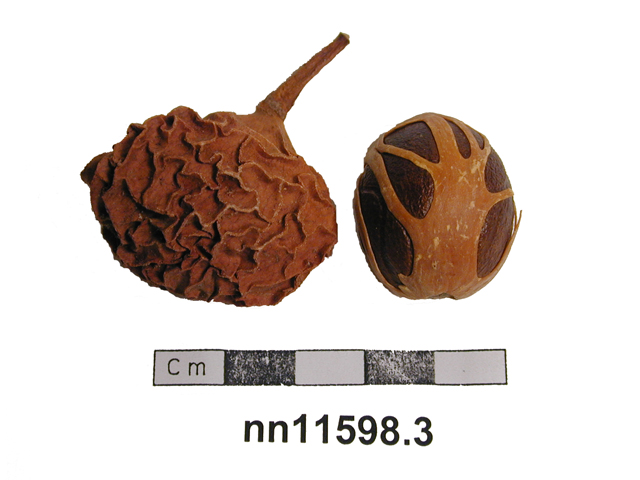I am African-Caribbean with a deep interest in the history and culture of the Caribbean.
My participation in the Horniman’s Community Action Research Project began when I learned of the Horniman’s 500 or so objects from the Caribbean, and that these objects were in storage!
It was my first experience of a museum having a ‘Caribbean collection’ with objects directly from that part of the world.
Bringing objects out of storage
I embraced the opportunity to choose and research an object of my choice; aiming to reveal its full story and bring it out of storage.
After viewing the Caribbean Collection online I was drawn to this sample of nutmeg.

sample (natural objects)
Anthropology
On reflection, it resonated because it connected me to my heritage: my parents’ place of birth, Grenada.
A small Island in the Eastern Caribbean commonly referred to as ‘Spice Island’ within the British Caribbean. Initially, it was colonised by the French, and later by the British until its independence in 1974. The National Flag has the colours of the nutmeg fruit and mace – green, red, yellow – and is accompanied by a graphic image of a nutmeg.

Grenada’s flag, Public domain
I decided to look at the objects through Grenada’s colonial history of trade and empire. Every aspect of the sample intrigued me.
The first aspect was that there was one number for two separate objects. I had immediate questions about how, when, and why these samples of nutmeg came into the Horniman’s collection.
The overriding question; was nutmeg indigenous to Grenada? If not, from where did it originate?
My online search of the collections gave so little information that I questioned if I was doing my search correctly! I was reassured that I was.
With guidance, I arranged the next step to view the objects in storage. This is not in the Horniman’s basement, as some might believe, but off-site in a former Victorian school building with all the windows boarded up! The formality in arranging this visit raised awareness of the care and protection given to objects in storage.
Visit to the collection stores and findings
During the visit, I was guided through information and handling the objects. Again, the knowledge gained did not answer any of my questions. Surprisingly, it answered one I did not pose, ‘where’ did they come from?’
I was confident they came from Grenada where nutmeg is known as ‘Black Gold’. Grenada was, and continues to be, the world’s second largest producer of nutmeg, after Maluku in Indonesia, its original source.
So I was stunned to read ‘St Vincents’ on the object label!

Maluku Islands By Lencer (own work), thanks to Sadalmelik CC BY-SA 3.0
Further collections searches for information on the objects – or to find an object from Grenada – were unsuccessful.
Initially, the outcome of the visit to the collection stores left me in limbo, unsure how to move forward.
Contact was eventually made with the Horniman’s Natural History and Anthropology departments. Although they could add no further information on the sample, I learned that the preceding ‘nn’ in the objects’ number denotes ‘no number’. Meaning these samples were possibly found and given a number at some point after they entered the Horniman collections. So, connections with any records telling their specific stories are lost!
That very unexpected information was a further shock. It was hugely disappointing, as it brought an abrupt end to the research on the sample.
However, as a result of my initial research I learned that during the colonial period, Grenada’s capital, St George’s, was also the administrative capital for the British Windward Islands. These islands included St Vincent. This information led to the idea of refocusing my research to look at nutmeg’s history in the Eastern Caribbean, through trade and empire.
The outcome to date
I valued the experience of seeing and handling the physical objects. It took me on an emotional journey, ultimately experiencing a sense of pride and joy.
Cultural knowledge and lived experiences are valid, important sources of knowledge. These influence our interpretation of an object.
In my case, it enabled me to recognise two mistakes in the records. Firstly, St Vincent was misspelt with the addition of ‘s’ at the end of the name; and secondly, one of the two objects was the dried unopened fruit, with its mace, shell and nut inside; the other was a nutmeg inside its shell, itself covered with mace.

The Horniman’s documentation, ‘Natural object sample consisting of nutmeg and mace (nutmeg shell)’ infers that the mace is the shell of the nutmeg.
This is incorrect. The mace is itself a spice that covers the nutmeg shell. Interestingly, though called a nut, it is a seed, and is the only tropical fruit that sources two different spices.
What did I take away from this?
Objects are very powerful carriers of stories and help us understand complex histories; nutmeg is an example.
While my research journey moved away from the Horniman’s objects, to focus on the history of nutmeg in Grenada, I uncovered an incredible amount of rich, hidden histories on the nutmeg trade in the Eastern Caribbean during the period of colonisation and beyond.
These findings have the potential to be developed further – into educational or cultural resources, workshops, or object handling are just a few examples.
Most important, the findings should be actioned to amend the objects’ historical and ethnographic documentation, to give the story of this sample of nutmeg in the Caribbean collection, albeit incomplete. Nonetheless, these findings help address the colonial legacy in the Horniman’s collections.
A powerful way to decolonise the collections and bring objects out of storage.


